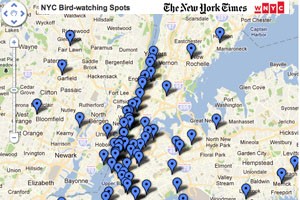As the ranks of journalists at news organizations shrink, one of our biggest news-gathering assets is our audience. We increasingly rely on users for tips and information via social media, and some companies are working overtime to make crowdsourcing news easier. One of the most interesting emerging uses for all that crowd sourced news is in mapping.
Applications like Everyblock have demonstrated the power of mapping news, but all kinds of individual stories can include mapped components. NPR’s “The Takeaway” set up a national gas prices map. The New York Times and WNYC asked users to share bird-watching spots. Following Haiti’s earthquake, users all over the world cobbled together a map of earthquake damage and relief sites to assist aid workers.
When selecting a topic or story for crowdsourced mapping, remember that the story should have longer-term potential and a strong geographic component. Setting up a crowdsourced map requires some legwork, so it’s worth making sure it has some kind of shelf life. In disasters, crowdsourced maps can locate damage or indicate where to find supplies and aid, but you should set them up and test them in advance. If you’re looking at crowdsourced maps for disasters make sure that they’re mobile compatible, and set up submission by sms or email.
For a very basic and fast crowdsourced map with a shorter shelf life, you can create a Twitter search map on uMapper. Just chose the Twitter template, center your map on your region and type in a search parameter. Twitter maps come in handy for recurring events with established hashtags or participants — like meet-ups, conferences or other events.
Crowdmap is a great platform to start crowdsourcing more complicated maps if you have limited programming knowledge. It’s open source, and easy to use. It accepts text, photo or video submissions via a web form, or over SMS, but you’ll have to do some extra work for that. Once you’ve set-up SMS integration, Crowdmap is a great choice for reporting emergencies. If you’re a bit more tech-saavy, you can dive right into Crowdmap’s engine, Ushahidi, to unlock more functionality.
If you prefer to set up your own submission system with a customized database, for example, check out Geocommons. You have more fine-grained control with how things are displayed in Geocommons maps, but you’ll have to do more setup to get started. You’ll also have to keep your data current. Geocommons is great for mapping recurring data or overlaying data sets, but it’s less flexible in breaking news situations.
Whether you’re trying to map something as simple as a Twitter search or reams of user-submitted data, mapping is a great way to aggregate individual users’ knowledge into an informative story.











